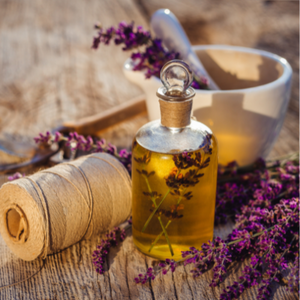Lavender is one of the most popular and versatile essential oils. It has a sweet, floral, and herbaceous scent that is both calming and refreshing. Lavender essential oil is extracted from the flowers of the lavender plant through steam distillation. The oil is clear and has a thin consistency. It is widely used in aromatherapy, skincare, and household products due to its numerous therapeutic benefits.
How does Lavender looks like?
The lavender plant is a sight to behold, with its delicate, narrow leaves and fragrant purple flowers that grow in long, slender spikes. When in full bloom, the lavender plant creates a stunning sea of purple, making it a popular plant for gardens and landscaping. In addition to its visual appeal, the plant is also known for its sweet, floral, and herbaceous scent, which is why it's used in so many different products. The fragrance of lavender is calming and soothing, making it a popular scent for candles, soaps, lotions, and other aromatherapy products.
Origin and History
Lavender essential oil has been used for centuries for its therapeutic and healing properties. Its history dates back to ancient times, when the Greeks and Romans used it in their bathing rituals, cooking, and perfumes. In medieval times, lavender was considered a holy herb, and it was believed to have healing properties. During the Renaissance, lavender was used to scent clothes and linen, and it was a popular ingredient in perfumes.
Lavender has also been used for medicinal purposes throughout history. During World War I, lavender essential oil was used to disinfect wounds and prevent infection. Today, lavender essential oil is still used for its healing properties, and it is commonly used to treat anxiety, depression, insomnia, headaches, and migraines. It is also a natural remedy for insect bites, burns, and skin irritations.
Healing Properties and Medicinal Use
Lavender essential oil has many healing properties. It is known for its calming and relaxing effects on the mind and body. It is also a natural pain reliever and has anti-inflammatory properties. Lavender essential oil is commonly used to treat anxiety, depression, insomnia, headaches, and migraines. It is also a natural remedy for insect bites, burns, and skin irritations. The oil can be diffused, applied topically, or ingested in small amounts under the guidance of a healthcare professional.
Use in Meditations and Spiritual Practices
Lavender essential oil is widely used in meditations and spiritual practices to connect with angels. The oil has an energetic signature that brings the angels closer and provides comfort and companionship. Lavender essential oil is associated with Archangels Gabriel, Raphael, Uriel, Chamuel, Jophiel, Metatron, Sandalphon, and Zadkiel. It is believed to awaken harmony and emotional balance and to lift the weight of depression and sadness from the spirit.
Symbolism in Different Cultures
Lavender has different meanings and symbolism in different cultures. In ancient Greece and Rome, lavender was associated with love and devotion. In Christianity, lavender is often used as a symbol of purity, cleanliness, and devotion. In Japan, lavender is a symbol of grace and elegance. In the Victorian era, lavender was a symbol of refinement and luxury.
In Conclusion
lavender essential oil is a versatile and popular oil with numerous therapeutic benefits. Its soothing and healing properties make it a popular choice for aromatherapy, skincare, and household products. It is also widely used in meditations and spiritual practices to connect with angels and to promote emotional balance and harmony. Whether you use it for its physical or spiritual benefits, lavender essential oil is a must-have oil for any essential oil enthusiast.










